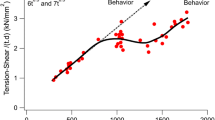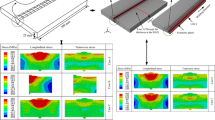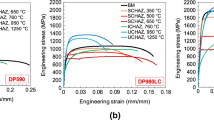Abstract
Effects of local plastic instabilities in the form of yield point phenomena (YPP) were investigated on local and global deformation and failure behavior of resistance spot-welded tension–shear (TS) samples made from M1700 advanced high-strength steel (AHSS) by means of finite element (FE) simulations. Material models with and without YPP were used in FE simulations, and sensitivity of results to YPP material model characteristics and failure criteria was investigated. Results from FE simulations revealed several stages of load oscillations in predicted global load–displacement curves with different amplitudes depending on material model with YPP. Results also showed the existence of heterogeneous distribution of equivalent stress in heat-affected zone (HAZ) of TS samples with strong sensitivity to the upper and the lower yield stress values in YPP material model. A stress-based failure criterion was added to the damage model to account for this stress heterogeneity, and results from this model showed that the loading and failure behavior of TS sample can significantly change from ductile to premature semi-brittle failure with significant reduction in strength of TS sample. Results from FE simulations were also compared with those from TS experiments and indicated the need for development of proper material and damage models suitable for materials with YPP.












Similar content being viewed by others
References
H. Ghassemi-Armaki, E. Biro, and S. Sadagopan, Advanced Characterization of HAZ Softening of AHSS for Crash Modeling, ISIJ Int., 2017, 57(8), p 1451–1460
H. Rezayat et al., Constitutive Properties and Plastic Instabilities in the Heat-Affected Zones of Advanced High-Strength Steel Spot Welds, J. Mater. Sci., 2019, 54, p 5825–5843
G.T. Hahn, Model for Yielding with Special Reference to Yield-Point Phenomena of Iron and Related Bcc Metals, Acta Metall., 1962, 10, p 727–738
T.L. Russell, D.S. Wood, and D.S. Clark, The Influence of Grain Size on the Yield Phenomenon in Steel, Acta Metall., 1961, 9(12), p 1054–1063
J. Winlock, The Influence of the Rate of Deformation on the Tensile Properties of Some Plain Carbon Sheet Steels, Trans. Am. Inst. Min. Metall. Eng., 1953, 197(6), p 797–803
A.H. Cottrell and B.A. Bilby, Dislocation Theory of Yielding and Strain Ageing of Iron, Proc. Phys. Soc. Lond. Sect. A, 1949, 62(349), p 49–62
H. Conrad and G. Schoeck, Cottrell Locking and the Flow Stress in Iron, Acta Metall., 1960, 8(11), p 791–796
J.F. Hallai and S. Kyriakides, Underlying Material Response for Lüders-Like Instabilities, Int. J. Plast., 2013, 47, p 1–12
D. Johnson, M. Edwards, and P. Chard-Tuckey, Microstructural Effects on the Magnitude of Lüders Strains in a Low Alloy Steel, Mater. Sci. Eng. A, 2015, 625, p 36–45
E. Hall, Yield Point Phenomena in Metals and Alloys, Springer, Berlin, 2012
G.T. Hahn, A Model for Yielding with Special Reference to the Yield-Point Phenomena of Iron and Related bcc Metals, Acta Metall., 1962, 10(8), p 727–738
R. Schwab and V. Ruff, On the nature of the yield point phenomenon, Acta Mater., 2013, 61(5), p 1798–1808
G. Van Rooyen, The Stress and Strain Distribution in a Propagating Lüders Front Accompanying the Yield-Point Phenomenon in Iron, Mater. Sci. Eng., 1968, 3(2), p 105–117
F. Yoshida, Y. Kaneda, and S. Yamamoto, A Plasticity Model Describing Yield-Point Phenomena of Steels and Its Application to FE Simulation of Temper Rolling, Int. J. Plast., 2008, 24(10), p 1792–1818
M. Maziere and S. Forest, Strain Gradient Plasticity Modeling and Finite Element Simulation of Lüders Band Formation and Propagation, Contin. Mech. Thermodyn., 2015, 27(1-2), p 83–104
J.F. Hallai and S. Kyriakides, On the Effect of Lüders Bands on the Bending of Steel Tubes. Part II: Analysis, Int. J. Solids Struct., 2011, 48(24), p 3285–3298
J.F. Hallai and S. Kyriakides, Bending Capacity of Tubes with Lüders Bands: Influence of Geometric and Material Parameters, Proceedings of the Asme 31st International Conference on Ocean, Offshore and Artic Engineering, Vol 3, 2012, p 507–512
H. Rezayat, S.S. Babu, H. Ghassemi-Armaki, Effects of Heat Affected Zone Softening Extent on Strength of Advanced High Strength Steels Resistance Spot Weld, Trends in Welding Research, Proceedings of the 10th International Conference, 2016, Tokyo, Japan
M. Smith, ABAQUS (2011) ‘ABAQUS Documentation’, Dassault Systèmes, Providence, RI, USA
Abaqus Unified FEA - SIMULIA™ by Dassault Systèmes®. 2017; https://www.3ds.com/products-services/simulia/products/abaqus/
R. Camsonne et al., C-11 Labeling of Pk11195 and Visualization of Peripheral Receptors of Benzodiazepines by Positron-Emission Tomography, Journal De Pharmacologie, 1986, 17(3), p 383–383
H.G. Koenigsberger, Philip-Ii of Spain—Pierson P, Am. Hist. Rev., 1977, 82(4), p 946–948
T.J.R. Hughes, The Finite Element Method: Linear Static and Dynamic Finite Element Analysis, Dover Publications, Mineola, 2012
J.S. Sun, K.H. Lee, and H.P. Lee, Comparison of Implicit and Explicit Finite Element Methods for Dynamic Problems, J. Mater. Process. Technol., 2000, 105(1), p 110–118
A.M. Prior, Applications of Implicit and Explicit Finite-Element Techniques to Metal-Forming, J. Mater. Process. Technol., 1994, 45(1-4), p 649–656
X. Hu et al., Comparison of Explicit and Implicit Finite Element Methods in the Quasistatic Simulation of Uniaxial Tension, Commun. Numer. Methods Eng., 1994, 10(12), p 993–1003
AWS D8.9M, Test methods for evaluating the resistance spot welding behavior of automotive sheet steel materials, 3rd ed., American Welding Society (AWS), Miami, 2012
M.M. Bouzekri et al., An Investigation of Failure Types in High-Strength Steel Resistance Spot Welds, Weld. World, 2010, 54(3-4), p 3–14
S. Dancette et al., Experimental and Modeling Investigation of the Failure Resistance of Advanced High Strength Steels Spot Welds, Eng. Fract. Mech., 2011, 78(10), p 2259–2272
S. Dancette et al., Investigation of the Tensile Shear fracture of Advanced High Strength Steel Spot Welds, Eng. Fail. Anal., 2012, 25, p 112–122
Y.P. Yang et al., Integrated Computational Model to Predict Mechanical Behaviour of Spot Weld, Sci. Technol. Weld. Join., 2008, 13(3), p 232–239
M.R. Wenman and P.R. Chard-Tuckey, Modelling and Experimental Characterisation of the Lüders Strain in Complex Loaded Ferritic Steel Compact Tension Specimens, Int. J. Plast., 2010, 26(7), p 1013–1028
Acknowledgments
The authors would like to acknowledge the financial support from ArcelorMittal Global R&D for carrying out this work.
Author information
Authors and Affiliations
Corresponding author
Additional information
Publisher's Note
Springer Nature remains neutral with regard to jurisdictional claims in published maps and institutional affiliations.
Rights and permissions
About this article
Cite this article
Rezayat, H., Ghassemi-Armaki, H., Bhat, S.P. et al. Uncertainties in Finite Element Analysis of Yield Point Phenomena in Advanced High-Strength Steel Spot Welds. J. of Materi Eng and Perform 29, 1272–1281 (2020). https://doi.org/10.1007/s11665-020-04593-4
Received:
Revised:
Published:
Issue Date:
DOI: https://doi.org/10.1007/s11665-020-04593-4




